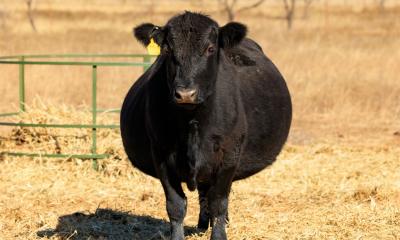Olivia Amundson
SDSU Extension Cow/Calf Field Specialist

Drought poses many challenges to the beef cow herd. Nitrates in feed is one of the challenges that producers need to be aware of, especially in the reproductive herd.
Nitrates can be found in multiple forages and weeds, such as millet, oats, wheat, corn, sorghum, sudan, kochia, pigweed, lambsquarter, brome grass and orchard grass, to name a few. Nitrates are taken up from the soil by the roots of the plant and through photosynthesis; the nitrates are converted into plant tissue as amino acids, proteins and other nitrogenous compounds. While all plants contain some nitrates, different management practices and unforeseen events can amplify the amount of nitrates found in forages. Conditions that can alter nitrate levels include: weather (drought, freezing, hail), herbicide and fertilizer applications and disease. The level of nitrates in a plant is dependent on stage of maturity, soil nitrate level, amount of sunlight/shade and the part of the plant (lowest 1/3 of the stem will contain the highest level of nitrate). As a result, it is important to test your forages for nitrate levels prior to feeding.
Pay Attention to Feeding Pregnant Cows
During drought conditions, grazing standing forage crops (such as millet, sudan, etc.) is a common practice. When considering grazing pregnant females, it’s important to understand that grazing management is critical to avoid nitrate toxicity and potential abortions. With the highest concentration of nitrate occurring in the lowest 1/3 of the plant, do not force cows to graze more than the leaves and upper stalks. By grazing only the leaves and upper stalks, this will reduce the inflow of nitrates, because animals are allowed to be selective and will consume the higher quality and more-palatable leaf material prior to the stalk. This is beneficial to decease toxicity. It is also important to consider stocking density of a pasture that may be slightly higher in nitrates. Typically, cows will be selective in their grazing; however, if overstocked, this allows for less opportunity to be selective and more opportunity to overgraze or ingest weeds, thus resulting in toxicity.
Nitrate poisoning can be lethal at high enough levels. Essentially what occurs is when forages high in nitrate are fed to livestock, it is converted to nitrite in the rumen. At high enough levels, nitrite, the toxic compound, is absorbed into the blood and causes decreased oxygen carrying capacity throughout the body. With enough nitrates, the oxygen carrying capacity of the animal decreases and can be lethal if not immediately removed from the nitrate source.
This becomes important when considering a pregnant female. If levels of nitrates become high enough, oxygen to the fetus decreases and early abortions can occur. If abortions are seen in the second and third trimester where visible dispelled fetuses present themselves, it is important to look for brownish-colored blood. This would indicate the fetus lacked the oxygen it needed for survival. If more than one female aborts with similar findings, it’s important to take appropriate action in feeding your reproductive herd. Unfortunately, warning signs of high nitrates in the cow prior to abortions are unlikely seen, as abortions may be the first warning sign.
During conditions of drought, it is a common practice to pregnancy test the herd early to find any open females. However, doing a later pregnancy check in the fall may be warranted, especially if the reproductive herd begins to show signs of open cows. Potential high nitrates may be to blame for open cows.
Therefore, pay attention to the level of nitrates to ensure cows do not reach a level that compromises fetal health. Abortions due to nitrate poisoning may not be preceded by some symptoms of nitrate poisoning in the pregnant female. Symptoms to watch for include blueish pigmentation around the eyes or mucous membranes and brownish-colored blood.
Managing Nitrates and What to Look For
South Dakota State University (SDSU) Extension has a Nitrate QuikTest available for standing forages. View our Nitrate QuickTest for Forages page for a list of individuals that can perform a quick test in your area. Testing prior to feeding forages or putting cows out on forage crops to graze is important to ensure cows do not consume toxic levels of nitrates. If levels of nitrates are high but within a level of caution, proper management when feeding needs to be taken. Supplementing cows while they adapt to the pasture of higher nitrates is key. This will ensure that cows are full and don’t over indulge, and it allows them to gradually adapt to higher nitrates. If feeding harvested feeds high in nitrates, they can be blended at different rates, depending on the level of nitrates in the forage. Refer to our publication, Frequently Asked Questions – Forage Nitrate Toxicity in Ruminant Livestock, for more information.
Symptoms to be aware of if nitrate poisoning is occurring include: difficult and rapid breathing, mouth breathing, rapid and weak heartbeat, below normal body temperature, muscular weakness loss of muscle coordination, blue coloration of mucous membranes, marked dilation of pupils, collapse and death. If any of these symptoms are noticed, pull animals from the feed source immediately and test the feed.
For questions regarding feeding nitrates contact your local SDSU Extension Cow/Calf Field Specialist.
